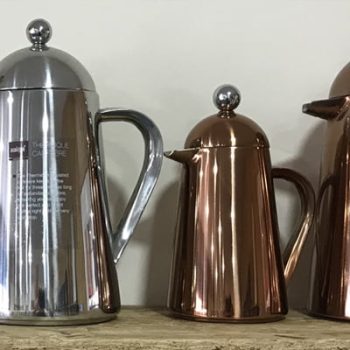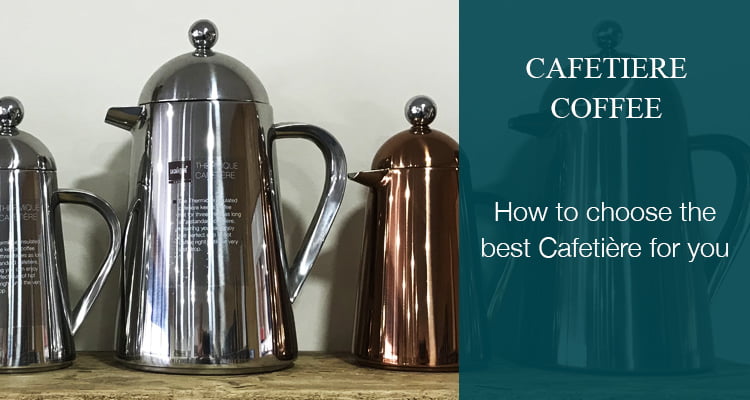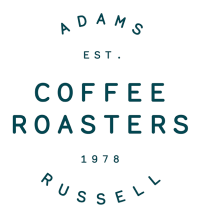

Looking for a cafetière that is best for you can be like looking for a needle in a hay stack.
So, in this full guide, we give you the ins and outs of size, shape and even insulation differences of cafetières available on the market.
In case you already have one and are wondering how to get the most from yours, have a read of our article – What grind should I use for my cafetiere?
On the other hand, if you’re interested in reading about the history of the cafetière. There’s an interesting article here – It discusses how the French and Italians are actually in dispute over the origins of this brewing method. The article in the link also explains how the first patents date back to 1928.
Use the links below to go directly to your preferred section
The first question you might be asking yourself is this:
Are all cafetières the same?
The short answer is, not really.
You can choose from many sizes, as well as levels of insulation – e.g. double walled or single walled. You even have different shines and colours to each.
Picking the one for you will depend on a few factors. From kitchen style to personal preference and even how many people you are providing coffee to.
Remember though, whether you use this or any other brewing method, the only coffee to drink is Adams + Russell fresh coffee – hint, hint.
Here’s a breakdown of the features and benefits you might want to look for when choosing your next cafetière.
Different Qualities Available
There are different qualities, which will make a difference to the price and your usage.
Is a single walled best?
Single walled cafetières have just one wall on the body that will keep the coffee warm. That means they generally cool down faster than a more insulated, thicker cafetière.
Single walled options are generally cheaper too.
So, if you’re first starting out with trying this as a brewing technique, a single walled could be a great option for you.
Then, if you find you don’t drink your coffee fast enough, or you want to make more in one go, you might want to opt for a double walled – here’s what that means.
Is a double walled best?
Some double walled cafetières claim to keep the coffee warm for up to 3 times longer than a single walled one.
If you’re going for a large one, and keeping the coffee in there for longer, then a double walled might be the best choice for you.
After all, you don’t want your lovely, fresh coffee going cold.
Note, the double walled option is usually the more expensive of the two.
Here’s an overview of the different styles you can get these in:
Styles
It’s true, most brand new cafetières will give any kitchen a sleek look and finish.
However, depending on your preferences and style of the room you want it to fit into, you may choose one of the following styles.
Copper
Copper finishes are sleek and expensive looking. They can fit beautifully into almost any kitchen.
Chrome, Satin or Stainless Steel
Chrome finishes look clean and sometimes quite ‘blingy’. They may help to light up most rooms because of their mirror style design.
The satin tends to be more of a brushed style and therefore slightly darker and less of a mirror-effect than chrome.
A mirrored stainless steel-finish is also an elegant addition to any kitchen.
Classic Glass
Glass cafetières are the old school classic option. Cheaper than most others and a great option when first trying out this brewing technique.
Which Size cafetière is Best?
It’s really important to note that cup sizes are smaller than your general use mugs.
For example, if you buy a 3 cup cafetière and you want to make 3 mugs of coffee, you will need to add a small amount of hot water to each mug.
That means, when brewing, you will need to determine how much coffee to use depending on your desired strength and on the size.
To work out exactly how many mugs you will get, simply halve the number of cups. So, in a 3 cup cafetière, you will get 1.5 mugs.
Another way of working it out is using the volume you get in each one with ml being the unit of measure.
See the list below for the corresponding sizes
- 3 cup = 350ml
- 4 cup = 500ml
- 6 cup = 750 ml
- 8 cup = 1 litre
- 12 cups = 1.5 litre
Is there a cafetière bigger than a 12 cup?
Unfortunately, Adams+Russell don’t stock any that are bigger than 12 cup.
Once you get over 1.5 litres in volume, they will become rather heavy to carry with one hand.
Are Cafetière’s actually any good?
Cafetière’s are great for making 2 or more coffees in one go.
Especially when you always want a fresh coffee.
Alternatively, if you always use fresh coffee beans and want to just make one, then we would recommend having a look at the Aeropress Coffee Maker.
What Other brewing methods are there?
If we’ve not convinced you that a cafetière is the best way to go, you can always try other brewing methods – Aeropress, Stove top espresso maker, V60 drip – to name just a few.

